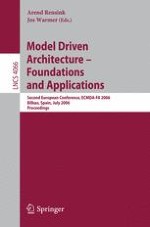2006 | Buch
Model Driven Architecture – Foundations and Applications
Second European Conference, ECMDA-FA 2006, Bilbao, Spain, July 10-13, 2006. Proceedings
herausgegeben von: Arend Rensink, Jos Warmer
Verlag: Springer Berlin Heidelberg
Buchreihe : Lecture Notes in Computer Science
